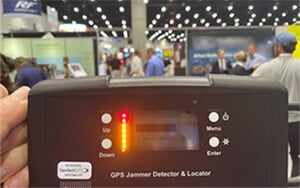As part of NavtechGPS’ involvement at the annual AUVSI Xponential conference, I have given many presentations about GNSS interference and jamming detection and how to help mitigate these real world issues. In the last eight presentations, I have asserted that “it’s not a matter of if, but when.” This was proven to be true this year in the exhibit hall. As part of the NavtechGPS exhibit booth we have two jammer detectors live and active on our table. On day two of the exhibit our Chronos CTL3510-LOG jammer detector started buzzing and the indicator lights lit up completely, indicating a strong GPS interference source. Trevor Boynton and I, wasting no time, grabbed the Chronos CTL3520 directional jammer detector to hunt down the jamming source. With 646 exhibit booths loaded with high tech gear and thousands of people in the hall we had our work cut out for us.

After looking for several minutes we narrowed it down to the exhibit booth on the right side of the photo, or so we thought. We saw equipment with antennas sitting on the table and thought that was a likely source. The person in the booth was being interviewed and videoed so we waited until that was complete before talking to the booth attendant. As we were approaching the booth Trevor noticed the buzzing of the CTL3510 had suddenly stopped and he realized it was the videographer’s equipment that was the interference source. They had disappeared into the crowd by the time Trevor realized what the source was. We now had to track down what was now a mobile jammer in the exhibit hall containing thousands of people. Several minutes later while walking, the CTL3510-LOG once again indicated a jamming source. We saw the people who were performing the interview and asked if we could speak with them about an interference source they were generating and were obviously unaware of. I’m sure this seemed to be a very strange request on our part but they obliged. After noticing dual antennas on the video camera we held the Chronos CTL3520 near the camera with no results. I asked if there was something transmitting to the camera, to which she replied the person doing the interview had a wireless microphone. We asked the interviewer if they would show us the transmitter. After the transmitter was removed from the suit pocket and adding full attenuation to the CTL3520 all indicator bars hit full levels when held over the transmitter. We had found our source among a sea of people and equipment within minutes. What made it possible to find the jamming source is the CTL3520’s very narrow reception beamwidth.
In the photo the videographer can be seen with headphones along with the interviewer to their left who, unbeknownst to us at the time, had a GPS jamming source in their pocket. We have observed that an estimated 90% of the jamming sources we have discovered have proven to be unintentional sources. This shows that GNSS interference can be anywhere and can come from very unexpected sources all around us. Finding the source is key to mitigating the interference. We don’t always have control over our environment, however. To help mitigate interference we recommend our line of GNSS receivers with AIM+ (Advanced Interference Mitigation) from Septentrio https://www.navtechgps.com/brands/septentrio/. This line has many different form factors to fit your project. AIM+ will allow you to manually, automatically or a combination of both, notch out interference sources and much more within a high quality GNSS receiver with and without INS. Let us know how we can help you find and mitigate GNSS interference sources.